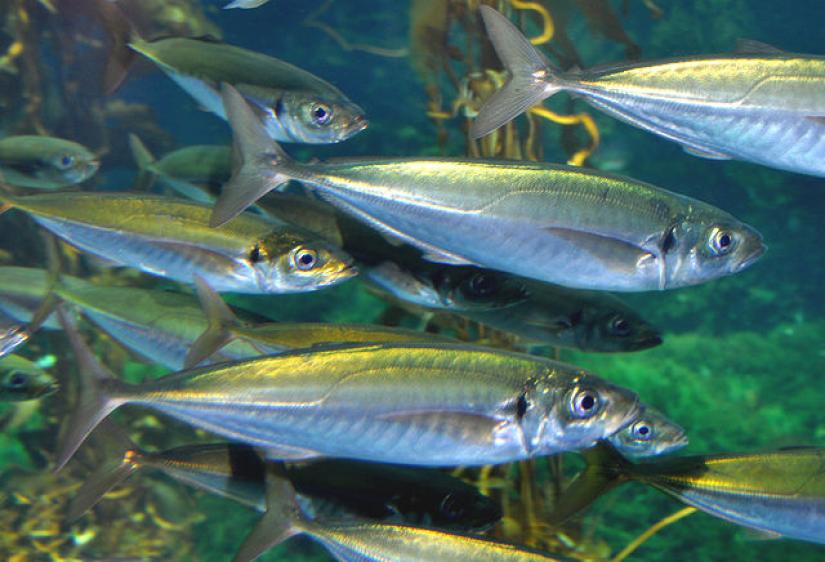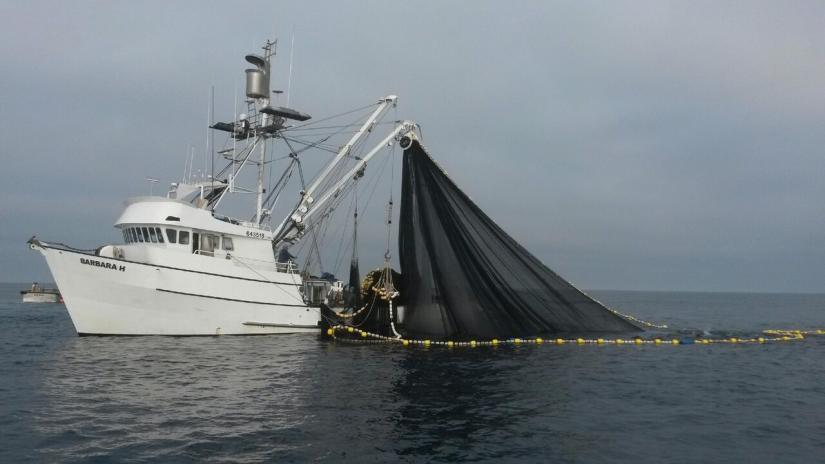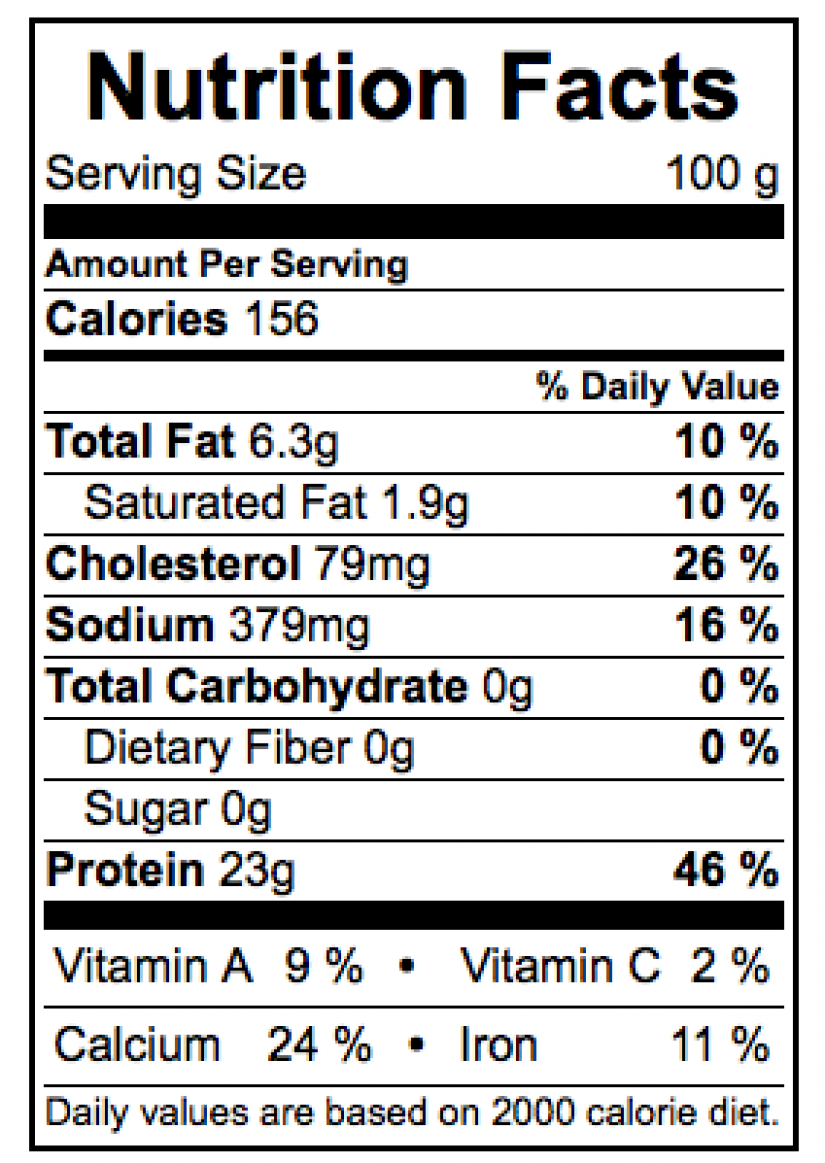Jack Mackerel
Trachurus symmetricus
The Science
THE SCIENCE
This fish is highly productive! It is a serial spawner, with females laying an average of about 34,000 eggs per spawning event.

Taxonomic description
- Scientific name means “naturally formed rough tail”.
- Average length of 55 cm (21.6 in). [3]
- Color ranges from metallic blue to olive green. [4]
- Dorsal fin has 8 spines followed by 31 to 33 rays. [4]
Distribution
- Found from the Eastern Pacific, from Southeast Alaska to Southern Baja California, Mexico, as well as in the Gulf of Mexico. [3]
Life history
- Eggs and larvae are commonly encountered beyond 320 km (200 mi) offshore. [5]
- Lives up to 30 years. [6]
- Matures at a relatively young age of one to three years. [6]
- Has the lowest adult natural mortality compared to every other pelagic schooling species in the same region. [5]
Habitat
- Adults are often found offshore- can be up to 800 km (500 mi) offshore, 400 m (1310 ft) deep. [3]
- Prefers subtropical regions at 8 degrees Celsius. [3]
- Found within mixed schools consisting of sardine, Pacific mackerel, and anchovy. [6]
- Primarily feeds on large zooplankton, juvenile squid, and anchovy. [2]
- Preyed on by larger tuna, billfish, and marine mammals. [7]
- A 1980’s decline in availability of Pacific and Jack mackerel [5] led to rapid expansion in the 1990s of the market squid and sardine fisheries in Southern CA. [5]
The Fishery
THE FISHERY
This fish is regulated along with other coastal pelagic fish, such as northern anchovy, market squid, Pacific sardine, and Pacific mackerel.

Seasonal availability
- Primarily caught from December through April. [5]
Regulatory and managing authority
- The Jack mackerel fishery is managed federally by NOAA fisheries and, as established by the Magnuson-Stevens Act, the Pacific Fishery Management Council (PFMC) through the Coastal Pelagic Species Fishery Management Plan (CPSFMP). [8]
- As established by the Marine Life Management Act, the California Fish and Game Commission (CFGC) regulates the fishery in state waters, and the California Department of Fish and Wildlife (CDFW) collects data and helps enforce FMP management rules for this fishery through the Pelagic Fisheries and Ecosystems Program. [13,14]
- The California Wetfish Producers Association combines input from the industry and government entities to inform regulatory and management measures for this fishery. [15]
Gear type
- Generally targeted with “round-haul” gear [8], such as purse seines, drum seines, lampara nets, and dip nets. [8]
- Also caught incidentally [8] in midwater trawls, pelagic trawls, gillnets, trammel nets, pots, and with trolls, hook-and-line, and jigs. [8]
Status of the fishery
- Peak catch occurred in 1953, bringing in 70,000 metric tons of yield. [6]
- Since 1991, catch averages have been less than 2,000 tons each year, composing only about 2% of CPS landings. [5]
- Acceptable Biological Catch (ABC) are allocated depending on distribution in US (65 percent). [8]
Potential ecosystem impacts
- Assessed with “Least Concern” in northeastern Pacific, there is no current indication of widespread population decline. [9]
- Midwater gear has minimal impact on environment because it does not contact seafloor. [1]
The Seafood
THE SEAFOOD
Some of the best barbeque fish are Mackerel species.


Edible portions
- The flesh is edible.
- The bones can be eaten if in canned form (boiled).
Description of meat
- Tastes similar to sardine.
- Dense, rich and oily.
Culinary uses
- Can be fried, baked, poached, grilled, marinated, smoked and barbecued. [1]
- Sold fresh, smoked, canned and frozen. [3]
- For a recipe for barbequed mackerel, visit BBC's Good Food. [10]
- A demonstration on how to filet and make mackerel sushi can be found on YouTube. [12]
Nutritional information
- Nutritional facts shown for drained, canned, jack, mackerel. [11]
Toxicity report
- Mackerel should be put on ice once taken out of the water, otherwise it will spoil quickly and can develop bacteria that leads to scombrid poisoning. [12, 16]
Seasonal availability
- Year round.
References
[1] Australian Fisheries Management Authority. Jack Mackerel. http://www.afma.gov.au/portfolio-item/jack-mackerel/. Accessed 28 May 2017.
[2] Pacific Fishery Management Council. Coastal Pelagic Species: Background. https://www.pcouncil.org/managed_fishery/coastal-pelagic-species/. Accessed 28 May 2017.
[3] Luna, S.M., N. Bailly. Trachurus symmetricus. Fish Base. http://www.fishbase.org/summary/Trachurus-symmetricus.html#. Accessed: 28 May 2017.
[4] Snow, J.T. Jack Mackerel. Mexico- Fish, Marine Life, Birds, and Terrestrial Life. https://mexican-fish.com/jack-mackerel/. Accessed: 28 May 2017.
[5] Mason, J., Bishop, T. 2001. Jack Mackerel. Pages 309-311 in W.S. Leet, C.M. Dewees, R. Klingbeil, E.J. Larson. California’s Living Marine Resources: A Status Report. California Department of Fish and Game, Richmond, CA. Web. https://nrm.dfg.ca.gov/FileHandler.ashx?DocumentID=34282&inline. Accessed 1 September 2020.
[6] Maccall, A.D., Stauffer, G.D. 1983. Biology and Fishery Potential of Jack Mackerel (Trachurus Symmetricus). CalCOFI Rep., Vol. 24. Web. http://calcofi.org/publications/calcofireports/v24/Vol_24_MacCall___Stauffer.pdf. Accessed 28 May 2017.
[7] California Department of Fish and Wildlife. Jack Mackerel. www.wildlife.ca.gov/Conservation/Marine/CPS-HMS/Jack-Mackerel#29347838-selected-articles-and-publications. Accessed 28 May 2017.
[8] National Oceanic and Atmospheric Administration. 2016. Coastal Pelagic Species Fishery Management Plan as amended through amendment 15. Pacific Fishery Management Council.. www.pcouncil.org/coastal-pelagic-species/fishery-management-plan-and-amendments/. Accessed 04 June 2017.
[9] International Union for Conservation of Nature and Natural Resources. Trachurus symmetricus. IUCN Red List of Threatened Species. http://www.iucnredlist.org/details/183729/0. Accessed 28 May 2017.
[10] Jackson, CJ. 2007, July. Barbecued mackerel with ginger, chili & lime drizzle. Good Food magazine. BBC Worldwide. https://www.bbcgoodfood.com/recipes/4465/barbecued-mackerel-with-ginger-chilli-and-lime-dri. Accessed 28 May 2017.
[11] Nutritional Value. Fish, drained solids, canned, jack, mackerel. NutritionValue.org. https://www.nutritionvalue.org/Fish%2C_drained_solids%2C_canned%2C_jack%2C_mackerel_nutritional_value.html. Accessed 28 May 2017.
[12] American Academy of Allergy, Asthma & Immunology. Histamine Toxicity. http://www.aaaai.org/conditions-and-treatments/related-conditions/histamine-toxicity. Accessed 28 May 2017.
[13] Marine Life Management Act. n.d. California Department of Fish and Wildlife. Web. https://wildlife.ca.gov/Conservation/Marine/MLMA. Accessed 24 August 2020.
[14] Overview of the Pelagic Fisheries and Ecosystems Program. n.d. California Department of Fish and Wildlife. Web. https://wildlife.ca.gov/Conservation/Marine/Pelagic#52132542-overview. Accessed 9 December 2020.
[15] California Wetfish Producers Association. 2013. California Wetfish Producers Association. Web. https://californiawetfish.org/. Accessed 2 December 2020.
[16] Buying Seafood. 2017. Species Spotlight: Mackerel. Web. https://buyingseafood.com/2017/02/27/species-spotlight-mackerel/. Accessed 13 January 2021.
[12] Outdoor Chef Life. Youtube. 2020. EATING PRACTICALLY LIVE SQUID+ Catch and Sushi Mackerel. Web. Accessed 17 February 2021.
[13] T.Tseng. flickr. 2016. Caballa con Sabores de Caesar: Jack mackerel, sweet garlic, braised romaine, soft egg. Digital image. Web. https://flickr.com/photos/68147320@N02/28558273400. Accessed 17 February 2021.



